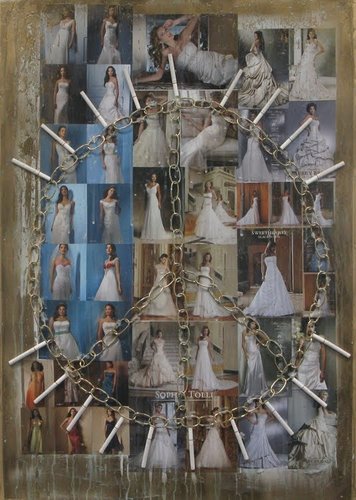John Hurrell – 8 November, 2009
Like Bob Dylan with his song title that I head this review with, is Cherrie being ironic or deadly serious? Perhaps he is having a laugh at the artworld’s eager propensity for gossip and scandal?
Derrick Cherrie is most well known for his series of witty furniture sculptures (Supraluxe Suite,1992) that slickly blended beds, swimming pools and gymnasium accoutrements into hybrid, body-sized, fetish objects. (The funniest, most entertaining sculptures ever created in this country, in my opinion.) His new show at Starkwhite’s backroom annex is infinitely more serious, though in parts, hinting he still has his tongue firmly in his cheek.
Framed two dimensional collages, with a surprisingly raw and gritty finish, these wall images make acerbic comments on the institution of marriage as perpetuated by romantic love – more specifically its commodification. The six works on paper, made with glossy pages from bridal gown catalogues, cigarettes, plastic gold-sprayed chains, and rendered peace logos and cagelike trellises, give out hard-hitting messages - firmly rejecting ideals of eternal conjugal devotion. The notion of a continuing partnership is rejected not so much for widely accepted, commonsense reasons like the fact that people change, but because for it to succeed, it involves the attendant proviso of male compromise.
The work seems antifeminist because there is no woman’s voice expressed. KING is an oft repeated noun here, and in one work, behind a heart of chain are the words HE WEARS. It seems to be angrily lashing out at loss of masculine sovereignty. If love and marriage go together like a horse and carriage, Cherrie’s horse swiftly ends up as dog tucker and the carriage, as splinters and kindling. His assault is merciless.
So much so, you wonder: (a.) Is this personal and genuinely emotive? Some hitherto private unhappiness in Cherrie’s own domestic relationship that’s bubbled to the surface. Or is it really (b.) just an abstract concept, a meditative art work about the ideas behind marriage, putting forward a ‘male viewpoint’ to generate debate – with no biographical input at all. Maybe it is about marriage’s marketing and selling to women. The consumerist side of public vow-taking that many men aren’t so enthusiastic about.
Or is it perhaps (c.) some much broader sociological statement about the institution; an anthropological examination of those human behavioural mores that underpin the social structure of families? Or is it (d.) - as part of the Starkwhite exhibition blurb suggests - really a specifically honed critique of the Eurocentric tradition of bridal glamour in high fashion? Or a homosexual attack on the heterosexual convention - when exclusive.
Like Bob Dylan with his song title that I head this review with, is Cherrie being ironic or deadly serious? Perhaps he is having a laugh at the artworld’s eager propensity for gossip and scandal? Hoping that his audience reads the work as somehow confessional and misogynistic. And that his partner will find it a bit of a hoot too?
According to Wayne C. Booth (A Rhetoric of Irony, Chicago 1974) and his analysis, for irony to be grasped it must have clues inserted by the artist; signposts that through calculated contradiction state to the viewer – ‘don’t take all that is before you at face value.’
There seems to me to be at least two distancing devices within Cherrie’s imagery: the Longbeach and Holiday cigarettes that he uses to write ‘King’ or render spiked dog-collars, and the lavender paint already alluded to (as a homosexual colour code) used in the top half of one work. To my knowledge (and general art-public knowledge too I think) neither he or his partner is gay or smoke, so these codes are deliberately placed to separate artist from art, as well as to enrich the theoretical content. Cigarettes could mean ‘love addiction’ and fear of loneliness, their brand names allude to honeymoons, and lavender could mean bisexual (‘pink’ and ‘blue’ mixed) non-marital distractions.
There are other possible meanings too. The spunk-like silicone portcullis of overlapping inverted and upright hearts present in one image could, like the cigarettes, refer to Stephen Heath’s famous essay The Sexual Fix and his discussion of our society’s construction of the desire for romance. It could also refer to Norman Mailer’s anti-feminist book The Prisoner of Sex.
Cherrie has created a clever exhibition that teases his audience on an autobiographical and anti-progressive level (if they want it), while providing other alternative examinations of philosophical and social issues too (if they want those instead). Much like his Supraluxe sculptures in fact – but with greater ambiguity and not so immediate experientiality. This work is more obviously coded, more complicated because of its back flips. Ostensibly it is angry not cool. You spot a trope and have to pause to evaluate if the work is joking or serious, is it from the viewpoint of an unreconstructed redneck or a SNAG? It forces you to mentally engage.



 Two Rooms presents a program of residencies and projects
Two Rooms presents a program of residencies and projects Advertising in this column
Advertising in this column



This Discussion has 0 comments.
Comment
Participate
Register to Participate.
Sign in
Sign in to an existing account.